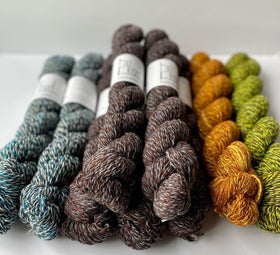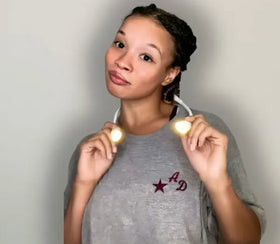Free in-store pickup available!

Curl up with a good ... yarn tag?
By Meg Dedolph
Remember in Harry Potter when the avuncular headmaster Albus Dumbledore made a comment about how he liked to read knitting patterns?
He’d obviously never seen a good yarn tag.
Here are a few tips to get the most out of the information that yarn companies give us.
- Yardage, or the amount of yarn in a skein. This is important if you’re planning to substitute yarns. If the pattern calls for 1,200 yards of a yarn that comes in 200-yard skeins, but you want to use a yarn that comes in 120-yard skeins, you’ll need this information to determine how many skeins of yarn to buy.
-
Recommended needle size: In the tag pictured, it says US 6-11, or 4-8mm. This is the range of needle sizes that the yarn manufacturer thinks will give you the best results. Can you go bigger or smaller? Sure. But you’re likely to get an overly tight or overly loose fabric that you may not like.
Crocheters, don’t worry. Hooks are labeled not only with a letter, but also with a millimeter (mm) size, so you can figure out what will work best with your yarn, even if a hook size isn’t specifically mentioned.You still have to swatch, though….. - Gauge: The sample tag says you’ll get 5-6 stitches to the inch. This is a ballpark estimate. It’s a good place to start if you’re picking out a yarn, but you still have to knit (and wash and dry) your own swatch on the needles you plan to use for your project.
- Fiber content: Learn a little bit about what kind of fiber works best for your project. Cotton and linen are good for summertime knits. Different sheep breeds give us different kinds of wool - Merino is soft, Blue-Faced Leicester, not as much. A little nylon in a sock yarn can help it stand up to being stuffed in a shoe all day.
- Care: Sometimes, you need a yarn that’s machine-washable, or sometimes, you know that you’ll handwash your finished item. Read the tag. Also, washing and drying a finished swatch will help you understand the best way to care for your item. Sense a theme?
- Lot number: Match your lot numbers if you’re using more than one skein. It will ensure the most uniformity in your finished item. Some yarns don’t have dye lots. In that case, line up the skeins you want to use, look at them under natural light and pick the ones that look the most similar.
For such a little piece of paper, yarn tags pack a lot of information - but as always, if you have questions about whether a yarn will work for what you want to do, ask. Albus Dumbledore isn't the only wizard who likes knitting.




Comments
Leave a comment